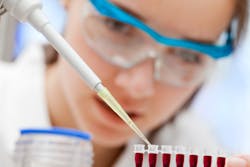Our pandemic response enhanced in-house capabilities in virology testing and beyond
Reflecting on the start of the COVID-19 pandemic, the memories are painful—the desperate need for clinical testing when none was available; quickly developing novel molecular COVID tests with the majority being imperfect; establishing and maintaining safe practices for handling COVID samples in the lab. Through teamwork and innovation, we persevered, eventually ramping up to perform 2,000 tests per day and, after three years, over 900,000 COVID molecular assays in total.1 This feat was achieved thanks in no small part to our industry partners, who maximized their expertise in developing some of the best nucleic acid amplification tests (NAAT) available—with sophisticated technology such as transcription mediated amplification (TMA) and polymerase chain reaction (PCR) to provide clinical labs with highly sensitive, reproducible, easy-to-use assays for SARS CoV2.
Overcoming the challenges of the pandemic made us a better lab. Our lab has been utilizing NAATs based on TMA technology for years, chosen for their excellent performance as well as the reduced likelihood of inhibition and contamination. Now, equipped with automated, easy-to-use molecular testing platforms and an expanded menu of in-house assays, we are becoming more effective advisors to our patients’ healthcare teams, and at the same time, training our staff in new skills like viral load (VL) assays to meet the dynamic clinical testing needs of the future. The diagnostic testing system we rely on today is easy to obtain and master, and we can now address clinical needs like human immunodeficiency virus (HIV) and hepatitis C virus (HCV) as a natural extension of the women’s health and sexually transmitted infection (STI) testing we have provided for years. The ways in which we have learned to maximize on our COVID-era investments are strategies that any hospital or community lab can apply, regardless of size, workforce, and testing volume.
Leveraging lessons learned at the local labs to control HIV and HCV
The healthcare community has made significant progress in caring for and treating people living with HIV. Over 50% of U.S. HIV-positive patients were older than 50 by 2016, and that population is expected to be ~70% by 2030.2 The cumulative effects of a larger population being monitored for HIV, plus that population living longer, forecasts a more acute need for individualized attention to test results as clinicians confront novel effects of aging with HIV as well as drug therapies taken for several decades. Even with successful viral suppression and barring side-effects, HIV infection is associated with accelerated aging and increased rates of cardiovascular, renal, neurocognitive, oncological, and osteoporotic disease.2 Yet, viral suppression is also critical to avoid transmission and new infections.
National efforts to limit the transmission of HIV include ambitious new programs such as the Ending HIV Epidemic (EHE), which sets the goal at fewer than 3,000 new infections per year beginning in 2030.3 Antiretroviral treatment has proven highly effective in maintaining non-transmissible VL for HIV-infected individuals and pre-exposure prophylaxis (PrEP) has shown exceptional results in preventing infection among at-risk patients.4 To achieve the ambitious EHE objectives, the Centers for Disease Control and Prevention (CDC) recommends substantially increasing both antiretroviral treatment and administration of PrEP.5 Local laboratories more intimately involved with patients are the ideal venues to provide regular testing, diagnosis, and VL monitoring with highly sensitive and reliable assays, and in turn ensure patients are quickly linked to the appropriate care for prevention or intervention.
In an effort to combat an increase in new HCV infections, the CDC Division of Viral Hepatitis, in cooperation with the Association of Public Health Laboratories (APHL), provided grants to support laboratories in at least 12 states seeking to add or expand HCV testing.6 Left untreated, HCV infection can become chronic in approximately 50% of patients, and nearly a fifth of those patients will develop serious morbidities including progressive liver fibrosis, cirrhosis, and liver cancer.7
Fortunately, HCV infection is curable in more than 90% of patients who receive timely treatment,7 which again places laboratory testing at the forefront—especially because both new and chronic HCV may be asymptomatic. The ideal candidate to coordinate these efforts is the local hospital laboratory where testing can be performed closer to the patient, where test results can be available in hours instead of days, and where clinicians can consult with pathologist colleagues to guide the often nuanced treatment decisions. For instance, because HCV shares corresponding risk factors with HIV, concurrent screening may be recommended, and many emergency departments around the country automatically screen for both infections unless the patient opts out.8 The local laboratory that can run these assays with a single sample, return accurate results quickly, and consult directly with clinicians will foster a better patient experience and better care.
HIV and HCV present unique challenges as life-threatening viral infections that many at-risk people avoid confronting due to persistent stigmas throughout various segments of society. We stand a greater chance at achieving the national infection reduction targets when patients feel supported by their healthcare team. Keeping testing local with in-house capabilities can play a significant role in the lives of people living with HIV. Reliable laboratory test results keep patients informed on their viral suppression and CD4 count, minimize follow-up visits, and reduce the anxiety caused by extensive turnaround times.
VL testing is an essential skillset worth developing
Within the laboratory, we are also very excited about making the most of our new capabilities to further develop the knowledge of our highly skilled staff. In the past, when we could not hire off the market, we created our own histology school as a one-year program, and many bright, motivated candidates who started as unlicensed lab aids, became full-time, licensed histology techs. Now, we envision similar success as we move all VL testing from the molecular virology lab to cytology, where personnel already have experience running HPV, chlamydia, gonorrhea, and trichomoniasis assays.
Many of our techs, already familiar with similar instrumentation, are in the perfect position to acquire the expertise necessary to become bona fide molecular techs—which in our lab means learning to troubleshoot quantitative assays. As these techs advance and become key advisors to clinicians, the rewards for their career, our lab, and ultimately for patients, will be very gratifying to see.
Conclusion
Clinical laboratories faced unprecedented challenges throughout the pandemic, but it is time to make good use of these past experiences and move on to new challenges. The lessons learned and technologies acquired can be used to seamlessly transition to address current and growing clinical needs—fulfilling the mandate to curtail HIV and HCV transmission and disease; engaging bright talent in the 21st century pathology laboratory; and continuing to cultivate in-house testing and local hospital resources to benefit our patients and to improve healthcare worldwide.
References
1. Data on File. ACL Laboratories.
2. Wing EJ. HIV and aging. Int J Infect Dis. 2016;53:61-68. doi:10.1016/j.ijid.2016.10.004.
3. Ending the HIV Epidemic. HIV.gov. Accessed June 12, 2023. https://www.hiv.gov/federal-response/ending-the-hiv-epidemic/overview/.
4. Prevention. Cdc.gov. Published February 2, 2023. Accessed July 17, 2023. https://www.cdc.gov/hiv/basics/prevention.html.
5. EHE progress. Cdc.gov. Published June 8, 2023. Accessed July 17, 2023. https://www.cdc.gov/endhiv/ehe-progress/index.html.
6. Expansion of hepatitis C virus (HCV) nucleic acid testing (NAT). APHL. Accessed July 17, 2023. https://www.aphl.org/rfp/Pages/HCV-NAT.aspx.
7. What is hepatitis C - FAQ. Cdc.gov. Published February 11, 2022. Accessed July 17, 2023. https://www.cdc.gov/hepatitis/hcv/cfaq.htm.
8. Newsom Governor G, Aragón TJ, Jacobson K, Ramos M. State of California—health and human services agency. Cdph.ca.gov. Accessed July 17, 2023. https://www.cdph.ca.gov/Programs/CID/DCDC/CDPH%20Document%20Library/DCL-Opt-Out-ED-HIV-HCV-and-Syphilis-Screening.pdf.
About the Author

Sonia Benhamed, PharmD, SMB(ASCP)
is Executive Director of Genetics at ACL Laboratories. She is a laboratory expert with over 20 years of experience in leading genetics laboratories.
